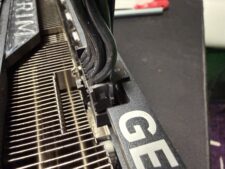Intel’s Latest Drivers Boost DirectX 11 Performance by 19% on Average
Intel Arc Alchemist GPUs landed about a year ago, and now compete among the best graphics cards. Drivers have been a recurring theme with Arc, both good and bad, but Intel has made strides to improve things and close the performance gap. To that end, Intel has released new drivers specifically aiming to improve its DirectX 11 performance.
We spoke with Intel earlier this week, and the gains for now are limited to specific games. To provide some background detail, after the initial Arc launch, Intel found that many of the base driver elements for their GPUs — integrated and discrete — were suboptimal, particularly for Arc. With integrated graphics, you can basically always assume that the GPU is the bottleneck. Anything that could be done to move work back to the CPU to alleviate that bottleneck was a “good thing.” Obviously, that same logic doesn’t necessarily apply any longer when the GPU becomes ten times faster, as in the case of the Arc A770.
So, since the initial launch, Intel spent a lot of time and effort reworking the drivers. We saw this first in early 2023 when Intel touted gains in DirectX 9 performance. The initial drivers for Arc leveraged Microsoft’s DX9 on DX12 tools, which provided compatibility and got things up and running. There was a lot of performance left on the table, however. We’re told Intel’s driver team worked with the open source DXVK project (DirectX on Vulkan) to optimize the various elements better — something it couldn’t do with the closed-source Microsoft tool. Eventually, things reached the state that all the DX9 support (or most of it?) was transitioned to using the new DXVK-optimized path.
We’re now getting a similar treatment for DirectX 11 games — not in the DXVK sense, but Intel has worked to build a from the ground-up different code path for DX11 support into its drivers. Since the existing DX11 support already works, even if performance isn’t ideal, the focus has been on testing specific games and then “whitelisting” them in the drivers to use the new code path. At present, Intel has whitelisted ten popular DX11 games: Apex Legends, Counter-Strike 2, Destiny 2, DOTA 2, Genshin Impact, GTA Online / GTA V, League of Legends, Middle-Earth: Shadow of War, Overwatch 2, and Valorant.
In short, the latest drivers optimize how the graphics hardware interacts with the DX11 API. By fine-tuning various parameters and implementing more efficient rendering techniques (it didn’t go into any low-level details), Intel improved overall performance on DirectX 11 games. Here are the results of its internal performance testing, comparing its latest drivers (internal versions 4571 and 4642, though version 4644 drivers are now out) with the original launch drivers (3490).
Across the ten games (eleven if you want to count GTA Online and GTA V as separate entries), the new DX11 code path boosted performance by anywhere from 5% to 33%. But what’s particularly interesting is that Intel specifically targeted the driver optimizations at “mainstream” CPUs — it tested with a Core i5-13400F and an Arc A750.
Later in the slides, Intel notes that the gains with a top-end Core i9-13900K weren’t as pronounced. The performance increased by only 0% to 28% across the selected games, with an overall average improvement of 12%, compared to the 19% seen with the Core i5 CPU.
We applaud Intel’s efforts and testing, as this makes a lot of sense for potential buyers of the Arc A750. With Arc A750 cards now starting at $199, they’re a great bargain, providing performance roughly equivalent to the RTX 3060 and RX 6700 10GB. Both of those still tend to sell in the $270 range (while supplies last on the 3060), meaning the A750 provides great bang for the buck. At the same time, while we might standardize all of our testing on a Core i9-13900K CPU to eliminate other bottlenecks as much as possible, people building a PC with an A750 aren’t likely to go much above $200 for the CPU, and that’s where the i5-13400F sits.
Intel had some other interesting news and bullet points to discuss. The major one is that PresentMon — the foundation of Nvidia FrameView, AMD OCAT, and CapFrameX — is getting an update. PresentMon was created by Intel as an open-source performance monitoring tool to capture frametimes and other metrics related to graphics performance. It has seen many updates over the years, and now Intel is joining AMD and Nvidia in offering a more robust solution.
The new PresentMon beta adds a GUI, making it far more user-friendly than the existing version. Intel has also added a bunch of new features, including a robust overlay, histograms, and more. There’s also a new “GPU Busy” metric, which shows how much time was spent waiting on the GPU versus waiting on the rest of the system. Minimizing this difference has been a key focus of the new drivers.
Intel continues to work on validating additional games with the new DX11 code path, and they’ll roll those into future drivers. Perhaps at some point, the new code will be deemed robust enough that Intel will simply flip a switch, and all games will default to it — and maybe instead have a blacklist where games known to have issues can stick to the older code.
The new drivers and the PresentMon Beta are available for anyone to try. In fact, the DX11 performance improvements discussed here have been present in the past three Intel WHQL driver releases. The full slide deck for Intel’s Q3’23 quarterly driver update is below for your reference.














